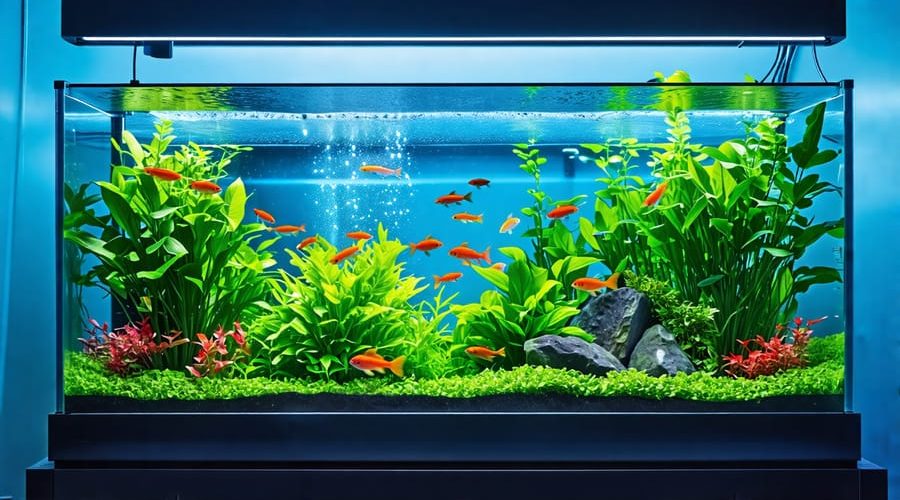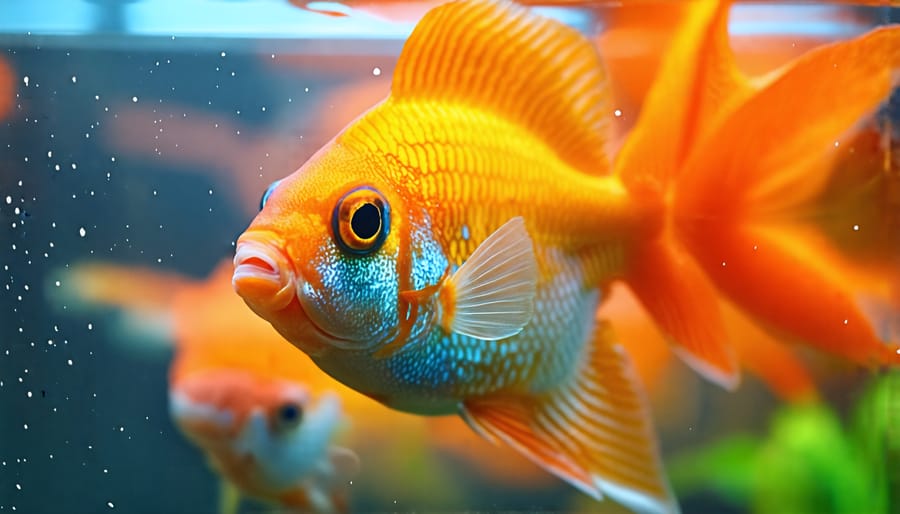
Aquaponics: The Genius Way to Grow Fish and Veggies Together
Discover the revolutionary world of aquaponics – a sustainable, symbiotic system that combines the best of aquaculture and hydroponics. In this innovative approach to food production, fish waste provides organic nutrients for plants grown hydroponically, while the plants naturally filter the water for the fish. The result is a closed-loop, eco-friendly system that uses up to 90% less water than traditional agriculture, eliminates the need for harmful pesticides and fertilizers, and yields healthy, abundant harvests of fresh fish and vegetables. Aquaponics offers a scalable solution for everything from small home setups to large commercial operations, making it a powerful tool in the quest for sustainable, locally-grown food. Join the aquaponics revolution and experience the wonder of this elegant, efficient system that’s transforming the way we grow our food.
How Does an Aquaponics System Work?

The Fish Tank
The fish tank is the heart of an aquaponic system, providing a habitat for the fish that power the symbiotic relationship with plants. When selecting a tank, consider the size of your system and choose materials like food-grade plastic, fiberglass, or glass. Ensure proper aeration and filtration to maintain optimal water quality for your fish.
Tilapia, catfish, trout, and bass are among the most common suitable fish species for aquaponics due to their hardiness and adaptability to varying conditions. These fish thrive in the controlled environment of an aquaponic system and efficiently convert feed into nutrient-rich waste for plants.
Fish are typically fed a high-quality, protein-rich commercial feed pellets. As they digest the food, they excrete waste in the form of ammonia, which beneficial bacteria convert into nitrites and then nitrates – the primary nutrient source for plants in the grow beds.
Maintaining proper stocking density, feeding rates, and water quality parameters like temperature, pH, and dissolved oxygen is crucial for fish health and productivity. Regular monitoring and adjustments ensure a balanced ecosystem where fish and plants flourish together.

The Grow Bed
The grow bed is where the plants are cultivated in an aquaponics system. It’s typically a shallow container filled with a growing medium that supports the plants and allows their roots to access the nutrient-rich water. Common grow media include expanded clay pebbles, gravel, perlite, and coconut coir. These materials are chosen for their ability to provide good drainage, aeration, and surface area for beneficial bacteria to thrive.
Plants can be started from seeds or seedlings and are planted directly into the grow media. The spacing between plants depends on the specific crops being grown and their mature size. As the plants grow, their roots spread throughout the media, absorbing the nutrients from the water that cycles through the system.
The depth of the grow bed varies but is usually between 6 to 12 inches deep to accommodate the root systems of the plants. Leafy greens and herbs tend to have shallower roots, while fruiting plants like tomatoes and peppers require deeper grow beds.
Some aquaponics setups use floating rafts instead of media-filled beds. In this method, plants are placed in net pots that sit in holes cut into floating styrofoam boards, with their roots dangling directly into the water.
Connecting the System
In an aquaponics system, water is constantly circulated between the fish tank and the grow bed, creating a symbiotic environment. A water pump, typically submerged in the fish tank, pushes the nutrient-rich water up to the grow bed. The water then flows through the grow media, providing moisture and nutrients to the plant roots, before draining back into the fish tank. This continuous cycle ensures that both the plants and fish have access to the resources they need to thrive.
Proper plumbing is essential for maintaining the balance and efficiency of the system. PVC pipes or flexible tubing are commonly used to connect the fish tank, grow bed, and any additional filtration components. The size of the pipes and the flow rate of the pump should be carefully considered based on the size of your aquaponics setup. It’s crucial to ensure that the water flows smoothly and evenly throughout the system, avoiding any stagnant areas or blockages that could lead to poor water quality or plant growth.
Benefits of Aquaponics Gardening
Efficient Resource Use
Aquaponics is a highly efficient method of growing plants and fish together in a closed-loop system. One of its key benefits is water conservation. In traditional agriculture, water is lost through evaporation and runoff. But in aquaponics, water is continually recirculated, with only minor top-offs needed to replace what’s used by the plants or lost to evaporation. This can result in using 90% less water compared to soil-based gardening.
Another efficiency of aquaponics is that it doesn’t require synthetic fertilizers. The fish waste provides a natural source of nutrients for the plants. Beneficial bacteria convert the fish waste, first into ammonia, then into nitrates that feed the plants. In turn, the plants filter the water, which returns clean to the fish. This symbiotic relationship eliminates the need for chemical fertilizers, creating a more sustainable and eco-friendly growing system.
Year-Round Gardening
One of the amazing benefits of aquaponics is the ability to grow plants indoors or in greenhouses year-round, regardless of the weather outside. This means you can enjoy fresh, homegrown produce even in the middle of winter! With the controlled environment of an indoor aquaponics setup, you have the flexibility to optimize conditions for continuous plant growth and harvests. Imagine picking ripe tomatoes or crisp lettuce leaves any time you want, straight from your own sustainable indoor garden. It’s like having a little piece of summer right in your home, 365 days a year.

Organic and Sustainable
Aquaponics is a truly organic and sustainable method of food production. By utilizing natural processes, it eliminates the need for synthetic fertilizers and pesticides commonly used in traditional agriculture. The symbiotic relationship between fish and plants creates a balanced ecosystem that mimics nature’s cycles. Fish waste provides nutrients for the plants, while the plants filter the water for the fish. This closed-loop system conserves water, as it is continually recycled with minimal losses. Aquaponics is not only efficient but also environmentally friendly, reducing the carbon footprint associated with food transport and production. It allows for local, fresh produce to be grown year-round, even in urban areas with limited space. By embracing aquaponics, individuals can contribute to a more sustainable future and enjoy the benefits of homegrown, healthy food in an eco-friendly way.
Getting Started with Your Own Aquaponics Setup
Choosing a System Type
When choosing an aquaponics system, there are several common setups to consider. Media bed systems use a growing medium like gravel or clay pebbles to support plant roots. Water from the fish tank is pumped through the media beds, providing nutrients to the plants. Nutrient Film Technique (NFT) systems feature shallow channels with a thin film of nutrient-rich water flowing through them. Plants are placed in cups with their roots suspended in the water. Deep Water Culture (DWC) systems involve floating rafts with plants growing through holes, their roots submerged in the nutrient-rich water below. Each type has its advantages – media beds are simple and effective, NFT allows for high planting density, and DWC is well-suited for leafy greens and herbs. Your choice depends on factors like space, budget, and the types of plants you want to grow. Experimenting with different setups can help you find the perfect fit for your aquaponics goals.
Essential Equipment and Supplies
To set up a basic aquaponics system, you’ll need a few key components. First, a fish tank to house your aquatic animals, typically filled with freshwater fish like tilapia, catfish, or koi. Next, a grow bed filled with a soilless medium like clay pebbles or gravel to support your plants. A pump circulates water from the fish tank to the grow bed, providing nutrients to the plants. PVC pipes or rubber hoses connect the components and direct water flow.
Monitoring equipment is essential to maintain optimal conditions. A pH test kit ensures the water stays between 6.8 and 7.0 for plant and fish health. A thermometer helps regulate temperatures around 70°F for most fish species. Adequate lighting, either natural or artificial grow lights, is necessary for plant growth.
Air pumps and air stones oxygenate the water for fish health. A mechanical and biological filter removes solid waste and converts ammonia to less harmful forms. Heaters may be required to maintain stable water temperatures. Finally, fish food and seedlings or seeds are needed to kickstart your aquaponics ecosystem. With these supplies and some careful monitoring, you’ll be well on your way to enjoying fresh, sustainable produce and fish.
Helpful Resources
Here are some helpful resources for learning more about aquaponics and connecting with other enthusiasts:
Aquaponics Nation – A beginner-friendly guide covering the basics of aquaponics systems, fish and plant selection, and troubleshooting. Includes helpful diagrams and videos.
Aquaponics Hub Forum – An active online community where aquaponics growers of all levels share tips, experiences, and support. Great for asking questions and learning from seasoned practitioners.
Aquaponics Fest – This annual conference brings together aquaponics experts, suppliers, and hobbyists for workshops, presentations, and networking. A fantastic opportunity to dive deeper and meet fellow enthusiasts in person.
Aquaponics Weekly – Subscribe to this free email newsletter for regular updates on the latest aquaponics news, research, and inspiration. Keeps you informed and motivated on your aquaponics journey.
